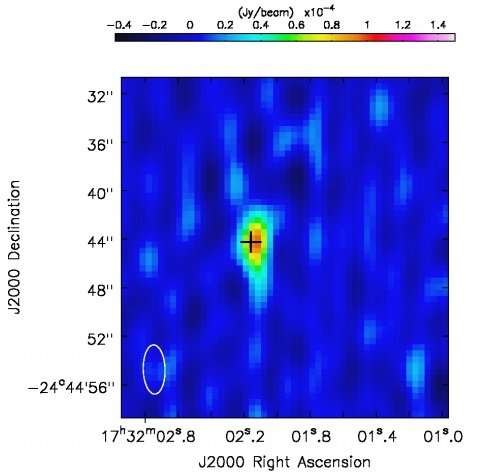November 13, 2017 report
Astronomers discover radio emission from a symbiotic X-ray binary

(Phys.org)—Using the Karl G. Jansky Very Large Array (VLA), an international group of researchers has detected radio emissions from the accreting X-ray pulsar and symbiotic X-ray binary system designated GX 1+4. It is the first discovery of radio emissions from a symbiotic X-ray binary and the first indication of a jet from an accreting X-ray pulsar with a strong magnetic field. The findings are reported November 6 in a paper published on arXiv.org.
Discovered in 1970, GX 1+4 is an accreting X-ray pulsar some 14,000 light years away with a relatively long rotation period of about 120 seconds. It accretes matter from its companion M6III-type red giant, V2116 Oph, which is circling the pulsar every 1,161 days. Therefore, the system was classified as a symbiotic X-ray binary (SyXRB) as it consists of a neutron star low-mass X-ray binary accreting from the stellar wind of a M-type giant donor.
GX 1+4's long-term spin has been a subject of interest for astronomers observing this system for many years. More recently, a team of astronomers led by Jakob van den Eijnden of the University of Amsterdam, Netherlands, has used the VLA observatory in New Mexico to conduct radio observations of GX 1+4 as part of larger program studying persistent low-mass X-ray binaries. As a result, they detected radio emissions from this pulsar.
"We report on the discovery of radio emission from the SyXRB GX 1+4 using the Karl G. Jansky Very Large Array (hereafter VLA). This detection constitutes both the first radio detection of a SyXRB and the first hints of a jet from an accreting X-ray pulsar with a strong magnetic field," the researchers wrote in the paper.
VLA allowed the astronomers to detect radio emission at 9.0 GHz with a flux density of about 105.3 µJy. However, the origin of this emission remains uncertain and the team takes into account several hypothesis that could explain this activity.
The scientists argue that the detected emission could be most likely caused by one of the three mechanisms: shocks in the interaction of the accretion flow with the magnetosphere, a synchrotron-emitting jet, or a propeller-driven outflow. They exclude the possibility that it is due the stellar wind from the red giant companion.
"We might observe radio emission from shocks as the accretion flow interacts with the magnetosphere. (…) Such shocks are compatible with the properties of GX 1+4 if the magnetic field is indeed as high as about 1014 G," the paper reads.
The researchers added that the shock scenario could be invalid if GX 1+4 has weaker magnetic field than estimated.
When it comes to the second possibility, the radio emission could also be synchrotron emission from a collimated jet. The authors noted that the luminosity of GX 1+4 is in agreement with the radio and X-ray luminosities in a large sample of low-magnetic field accreting neutron stars, where radio emission originates from such jets. They added that if this hypothesis is true, it would show that strong magnetic fields (above one trillion G) do not necessarily suppress jet formation.
Finally, the researchers suggest that the radio emission could be explained by a magnetic propeller. They emphasized that such an outflow has been inferred from previous X-ray observations in two other high magnetic field X-ray pulsars.
All in all, more observations of GX 1+4 are needed, especially simultaneously at radio and X-ray wavelengths, in order to choose the most plausible theory and to better understand the nature of its radio emission.
More information: Discovery of radio emission from the symbiotic X-ray binary system GX 1+4, arXiv:1711.01958 [astro-ph.HE] arxiv.org/abs/1711.01958
Abstract
We report the discovery of radio emission from the accreting X-ray pulsar and symbiotic X-ray binary GX 1+4 with the Karl G. Jansky Very Large Array. This is the first radio detection of such a system, wherein a strongly magnetized neutron star accretes from the stellar wind of an M-type giant companion. We measure a 9 GHz radio flux density of 105.3±7.3 μJy, but cannot place meaningful constraints on the spectral index due to a limited frequency range. We consider several emission mechanisms that could be responsible for the observed radio source. We conclude that the observed properties are consistent with shocks in the interaction of the accretion flow with the magnetosphere, a synchrotron-emitting jet, or a propeller-driven outflow. The stellar wind from the companion is unlikely to be the origin of the radio emission. If the detected radio emission originates from a jet, it would show that that strong magnetic fields (≥1012 G) do not necessarily suppress jet formation.
© 2017 Phys.org





















